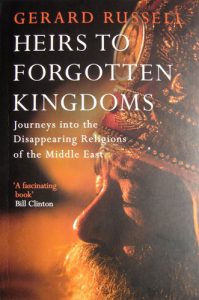Heirs to Forgotten Kingdoms. Journeys into the Disappearing Religions of the Middle East
Gerard Russell
Simon & Schuster UK, London 2014
373 p. £ 9.99
paperback ISBN 978-1-4711-1471-7
e-book ISBN 978-1-4711-1472-4
Gerard Russell is a former diplomat who spent a lot of time with followers of minority religions in the Middle East. His book covers the Mandaeans, Yazidis, Zoroastrians, Druze, Samaritans, Copts, and Kalasha.
In the foreword Rory Stewart calls these religions ‘pagan’ (in quotation marks) and contrasts their survival under Islam with the elimination of ‘pagan’ (again in quotation marks) beliefs under Christianity. The first words of Gerard Russell’s own introduction are: “Imagine that the worship of the goddess Aphrodite was still continuing on a remote Greek island…” Invited to meet the high priest of the Mandaeans, the author writes: “it was like being summoned to meet one of the Knights of the Round Table…”
All this may give the impression of a timeless continuum of ancient rites, not subject to changes from within or influences from outside, like flies captured in amber. The amber-coloured photo on the cover has a nostalgic feel, only enhanced by the words “forgotten” and “disappearing”. This sentiment is somewhat misleading, since the Middle East is anything but an island, and its inhabitants are people of our time, whose religions sometimes happen to have ancient roots. As most religions do.
The Copts, for instance, who are Orthodox Christians, use a calendar that at least partly dates from the time of the pharaohs, Russell tells us, “with months called Baramouda, Kiahk (the ‘month when the spirits gather’) and Thout (named after the baboon-headed god Thoth)”, and they sing hymns in the same way priests in Alexandria sang in the 3rd century B.C. But similarities of Coptic religious observances to the religion of Ancient Egypt are no reason to call the religion ‘pagan’ instead of Christian, not even if they are obviously derived from ancient practice.
To be fair, Gerard Russell does not use the word ‘pagan’ himself, and he tones down the ‘forgotten’ when he writes that a Druze, on hearing the title of the book, remarked: “We have not forgotten.” As for the ‘disappearing’: he cites British writers who already in the 18th and 19th century thought the Samaritans were on the verge of extinction and notes: “They have all been proved wrong.”
Most ‘pagan’ in the familiar sense of that word, among the people Russell visited, are the Kalasha, who live in a Himalayan region that used to be called Kafiristan (‘Land of the Unbelievers’). British agents in the 19th century noticed that some Kalasha had had blond hair and blue eyes, and ‘European’ habits like sitting on chairs and shaking hands. They spread the idea that the Kalasha were a “lost Hellenic tribe” and descendants of the army of Alexander the Great. An oral tradition of the Kalasha mentions Shalak Shah as their ancestor, which may be the same as Alexanders general Seleucus, who after Alexander’s death reigned over the eastern part of his empire.
Over the last centuries, some of the Kalasha have converted to Islam. The non-converted Kalasha drink wine and worship several gods. For instance Jestak, goddess of the family (could this be Hestia?). Kalasha life is structured according to pairs of opposing principles: men are connected with the right hand, purity, high mountains, and other things, and therefore men sit on the right-hand side of the houses and herd goats in the mountains. Women plant crops in the valleys, with which they are affiliated. If a person who has not been purified for a festival touches a house that has been purified, not only that house becomes impure, but also the houses below it on the mountainside. Purification is done by burning juniper branches. An important festival is Chaumos, the winter solstice.*
Heirs to Forgotten Kingdoms is a pleasantly written introduction for the general public to some of the less known historic, political, and of course religious aspects of the Middle East. It also casts light on phases in the development of Christianity and Islam. However, it may not be the best book if you are looking for an academic study of these subjects. Although the author has consulted outstanding scholars, some of his conclusions seem too enthusiastically arrived at, and some descriptions are confusing or puzzling. Like the baboon-headed Thout: the baboon is indeed associated with Thoth, but the portrayal of the god with an ibis-head is more common. Or the statement that “Persepolis is a city of white marble (…)”, whereas Persepolis is built with local types of dark and lighter grey limestone that possibly may look like marble, but definitely not white. A more general difficulty presents the section ‘Sources and Further Reading’ in the back of the book: a collection of remarks suspiciously looking like notes, but not numbered or referring to page numbers, which makes it a bit of a puzzle to find the right note at the right time.
Still, the book is worth reading. It is a great travel book; very entertaining with lots of vivid descriptions and thought-provoking or amusing tales. It is, for example, an interesting notion that our habit of greeting people with a handshake may be inherited from the cult of Mithras in the Roman Empire. Or that Pythagoras’ theorem of the triangle (a2 + b2 = c2) had an esoteric meaning as well, based on the symbolism of the numbers 3 (‘man’), 4 (‘justice’), and 5 (‘marriage’): “Man must behave justly in marriage.” The Pythagorean number for ‘woman’ however was 2… I’ll leave you to your own conclusions!
*) I believe Russell visited the Kalasha in Nuristan, the Afghan part of the region. In the Pakistani part, in Chitral, they are called Kalash. They call the winter solstice Chitramas, and they are trying to get their traditions on the Unesco Cultural Heritage list.

